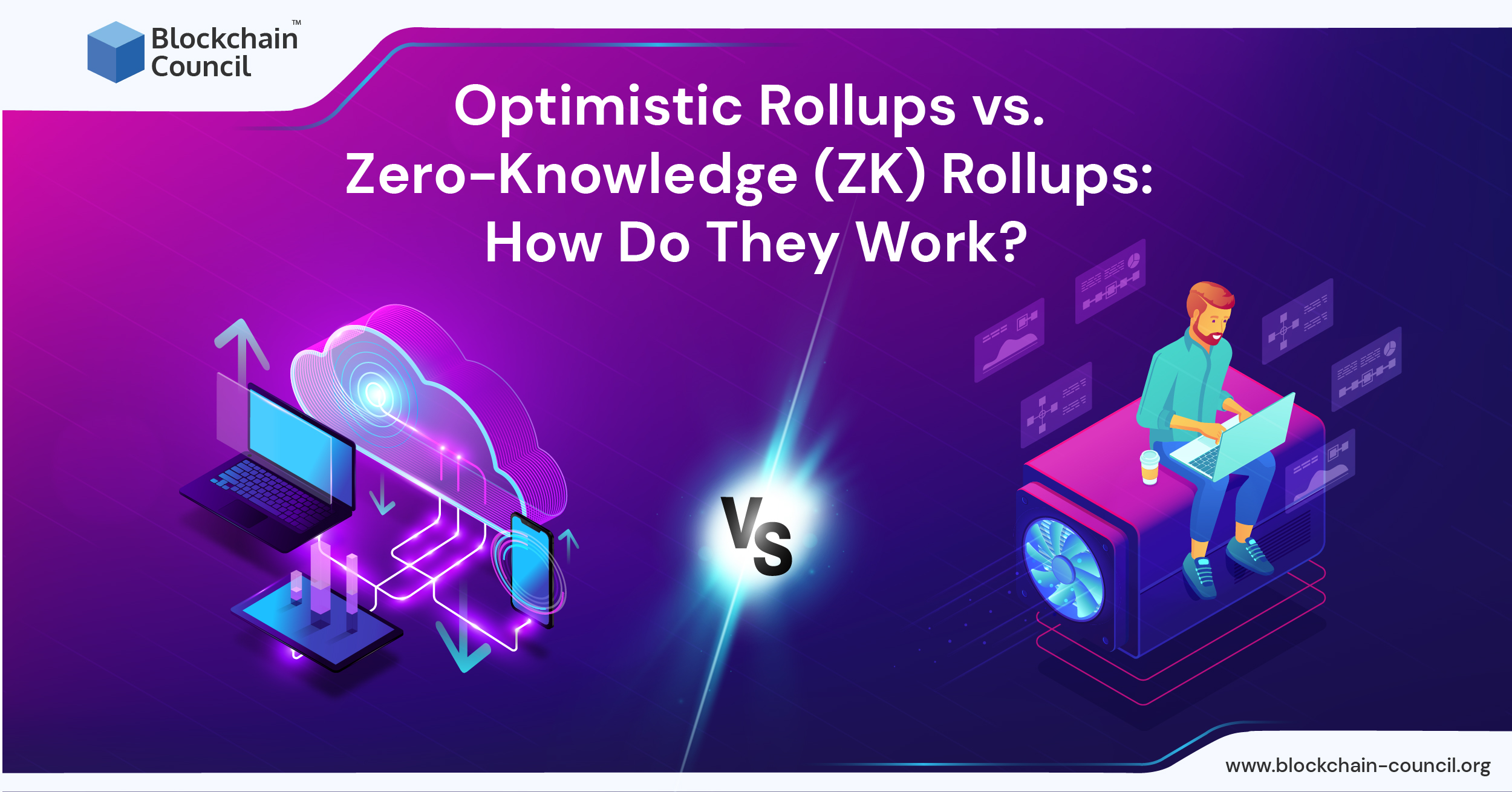
- Blockchain Council
- October 07, 2022
The rise of Ethereum is promisingly performing for many sectors along with significant setbacks. It provides the ideal ground for the particular growth of many new innovative blockchain products like NFTs and DeFi. Ethereum and its decentralized ecosystem are expanding due to the constant development of new applications and innovation. The outstanding growth in the network activity is now resulting in rising debates between optimistic rollups versus zero knowledge rollups for identifying the best suitable scaling solution.
Transactions on Ethereum are becoming quite costly with every passing day, therefore calling for the urgency of specific scaling. Rollups can give out the ideal scalability solutions, albeit with crucial security properties and trust assumptions. The distinctions between these two layer 2 scaling solutions might assist you in determining the optimal alternative for your scalability requirements.
This blog will help you analyze the differences between zero-knowledge (ZK) rollups and optimistic rollups. It will also help you choose the best Ethereum developer course with certification to become an Ethereum expert.
What do you mean by Ethereum 2.0 Rollups?
Before we get into optimistic rollups vs. zero knowledge rollups, you must have a fundamental understanding of rollups to be an Ethereum expert. Rollups are one of the most popular options among the solutions of layer 2 scaling and operate by processing transactions within smart chains. At the same time, it can ensure transaction data storage on a particular Ethereum chain, enhancing security compared to layer 1 networks.
Types of Ethereum roll-ups
Ethereum rollups are categorized into two different categories. These are optimistic rollups and zero knowledge rollups.
Optimistic Rollups
Optimistic rollups perceive that all the rolled-up information is correct and that no one is mainly attempting to deceive the effective blockchain by concealing pretentious operations within rollups.
Zero-Knowledge Rollups
Zero-knowledge Rollups, popularly known as ZK rollups, in a specific manner is unique. They depend on a significant type of encryption known as zero-knowledge proofs, which efficiently enable anyone to mathematically illustrate the correctness of any logic or comment without revealing extensive knowledge about that assertion.
Who is building Rollups?
Rollups with ZK
- Loopring: A L2 protocol that allows for non-custodial gas-free decentralized trade.
- ZKSync: Popular L2 scaling and privacy engine based on zero-knowledge proofing.
- Immutable X: Highly scalable, non-custodial L2 protocol for NFTs
Rollups that are optimistic
- Optimism: Cheap, scalable, EVM-equivalent architecture based L2 extension of the existing Ethereum software.
- Boba Network: Hybrid computational platform and L2 .scaling solution that utilizes Optimistic Rollups
- Arbitrum Bridge: Ethereum L2 scaling chain.
Optimistic rollups vs ZK rollups
Comparing optimistic rollups versus ZK rollups from a generic point of view gives a specific impression of which one is faster and more cost-efficient. However, it is essential to adequately evaluate their differences on different critical aspects, including transaction finality, Defi’s readiness, security transaction costs, and user experience.
Here is an overview of the comparison among the two popular layer 2 scaling solutions.
Transaction Finality
How fast can you withdraw the tokens generated in layer 2 transactions?
Optimistic rollups could represent a significant drawback in this case as they significantly feature a one-week delay in the challenge period. You as a user have to wait through the challenge period before you withdraw the funds, thereby it causes a delay in the transaction finality.
On the other hand, ZK rollups enable immediate withdrawal of the funds as a reason for the validity proofs. Since the validity proves unquestionable proof of the legitimacy of off transactions, you as a user do not have to experience delays with withdrawing funds.
Ready for DeFi
Recently improvised documents about arbitrum ensure simplicity of the process for migrating applications. Therefore you are less likely to confront issues, notably achieving the set of functionalities of alternative EVM-supported scaling solutions in the specific optimistic rollups.
Whereas compatibility is a significant and critical issue for the protocols of ZK rollups. The basic need for validity proofs for every type of transaction in the segment of ZK rollups issues complexities for developing the roll-up technology. It serves promising results in the field of use cases across discrete tasks like direct transfer and trading.
Validity proof
The most noticeable point of difference in ZK rollups versus optimistic rollups comparison brings attention to the validity proof. As a significant fact, it is the first point of difference between the two layers of scaling approaches introduced in this discussion. In the specific case of ZK rollups, you mainly have validity proofs about ZK proof techniques to ensure transaction validity effectively.
On the contrary, optimistic rollups do not come with inheritance validity proofs. You, as a user, would have to challenge a specific transaction bundle in optimistic rollups for the significant computation of fraud proofs to determine the validity of transactions.
Ease of Programming
You can speculate that data compression flexibility and EVM compatibility are vital highlights of the optimistic rollups for ensuring ease of programming. The specific data compression advantages in optimistic roll-ups help effectively publish complete transaction data to Ethereum’s necessary and leading network as detailed call data.
In contrast, ZK rollups do not need significant publishing transaction data on Ethereum. The particular ZK-STARKs and the ZK-SNARKs are held responsible for efficiently verifying the accuracy of the rollup state. Nevertheless, you still struggle with programming the significant ZK rollups, which require clear cryptographic proof.
Transaction Costs
Optimistic rollups represent a knowledgeable, optimistic view on the segment of cost as you invest only in the particular areas that matter of scalability. The roll-up prices are considerably lower as the optimistic rollups significantly depend on publishing minimal amounts of data on Ethereum. Without needing to provide proof for a transaction unless it is challenged in an impressive number of cases. Moreover, the support of EIP 4844 protocols can help make optimistic rollups cheaper for you.
On the other hand, ZK rollups accompany massive amounts of cost as a reason for computational proof. The excessive amount of overhead accounts for the cost associated with the verification creation of the evidence for the different numbers of transaction blocks.
Trust
The significant element of trust also issues one of the critical determinants in the Ethereum layer 2 comparisons based on different factors. You do not need a trusted set-up in the case of optimistic rollups. However, ZK rollups depend on a specific trusted setup for acquiring desired functionality.
Live Monitoring
In the scenario of ZK rollups, you do not have to think about monitoring the layer 2 chain in real time for the detection of fraud. Contrarily, the verifiers must maintain track of the fundamental role of the state along with the one referred to in the state route to enable fraud detection for optimistic rollups effectively.
Security
The aspect of security in optimistic rollups effectively depends on crypto-economic incentives for users like you to ensure roll-up safety. At the same time, ZK rollups depend on the cryptographic security proof with ZK proofs. Therefore both these roll-up types are placed toe to toe with each other in a competition on a security basis.
Final Thoughts
ZK rollups tend to appear as a more secure alternative in comparison to Optimistic rollups due to the utilization of cryptographic proofs.
On the other hand, optimistic rollups are contemplated to be a better candidate for Defi’s projects with the EVM’s compatibility. At the same time, ZK Rollups with the compatibility of EVM can change the powerful narrative for layer 2 scaling solutions.
We at Blockchain Council provide in-depth courses and certification to become an Ethereum developer and expert. 30,000+ learners worldwide have already enrolled for our courses, which have helped them bag high-profile jobs at top web3 and blockchain companies. Contact us today to get suitable Blockchain and web3 education and kickstart your web3 journey.

































































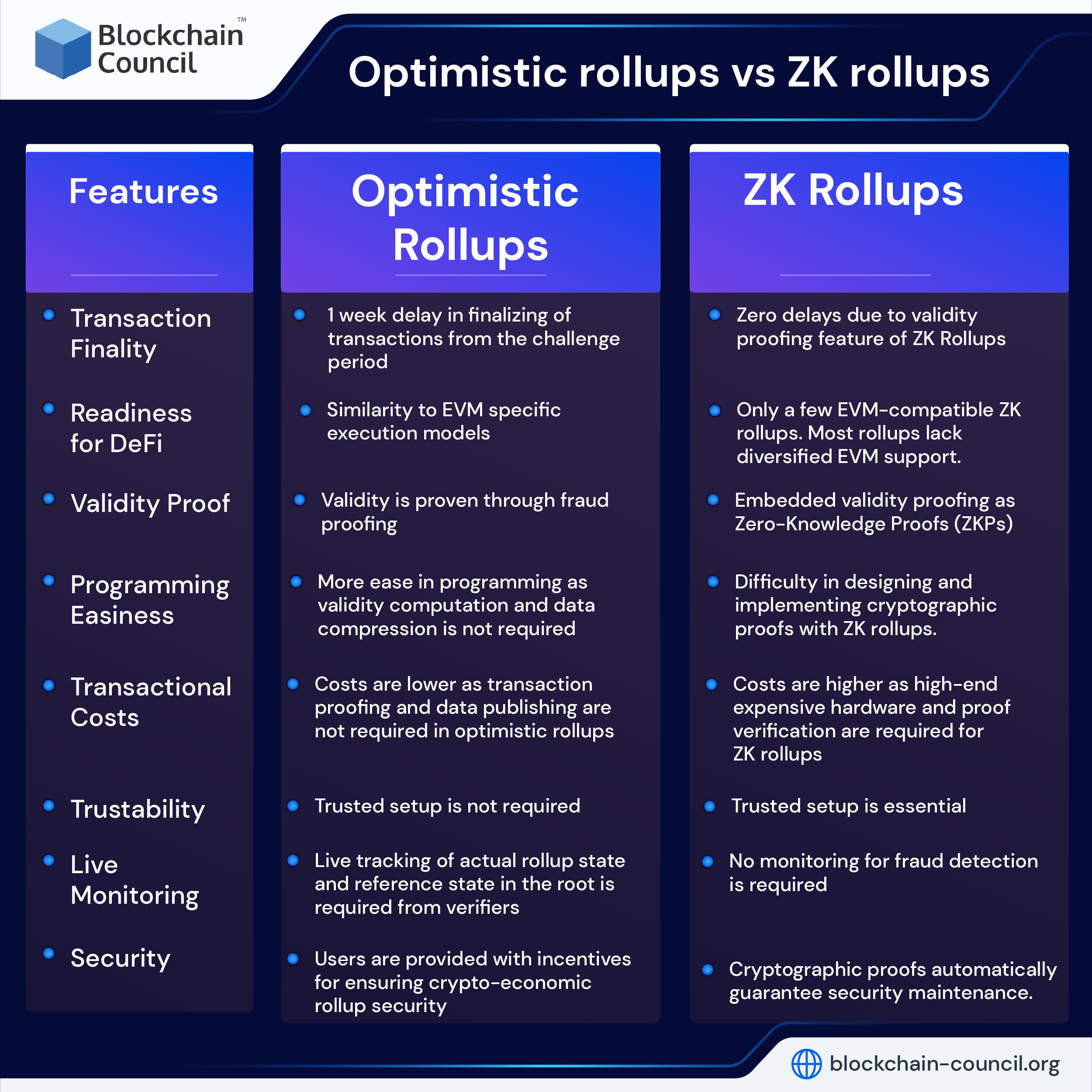
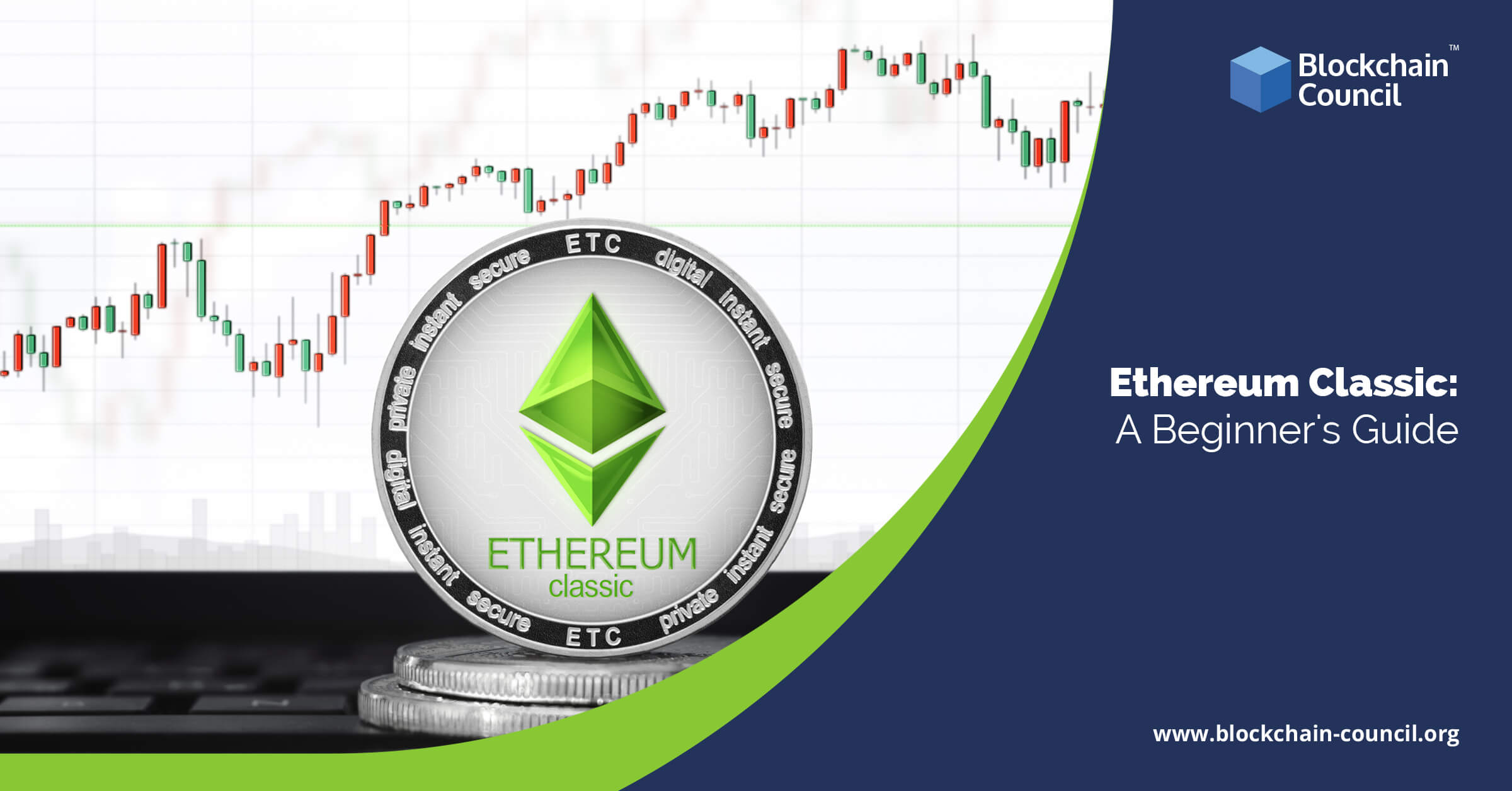

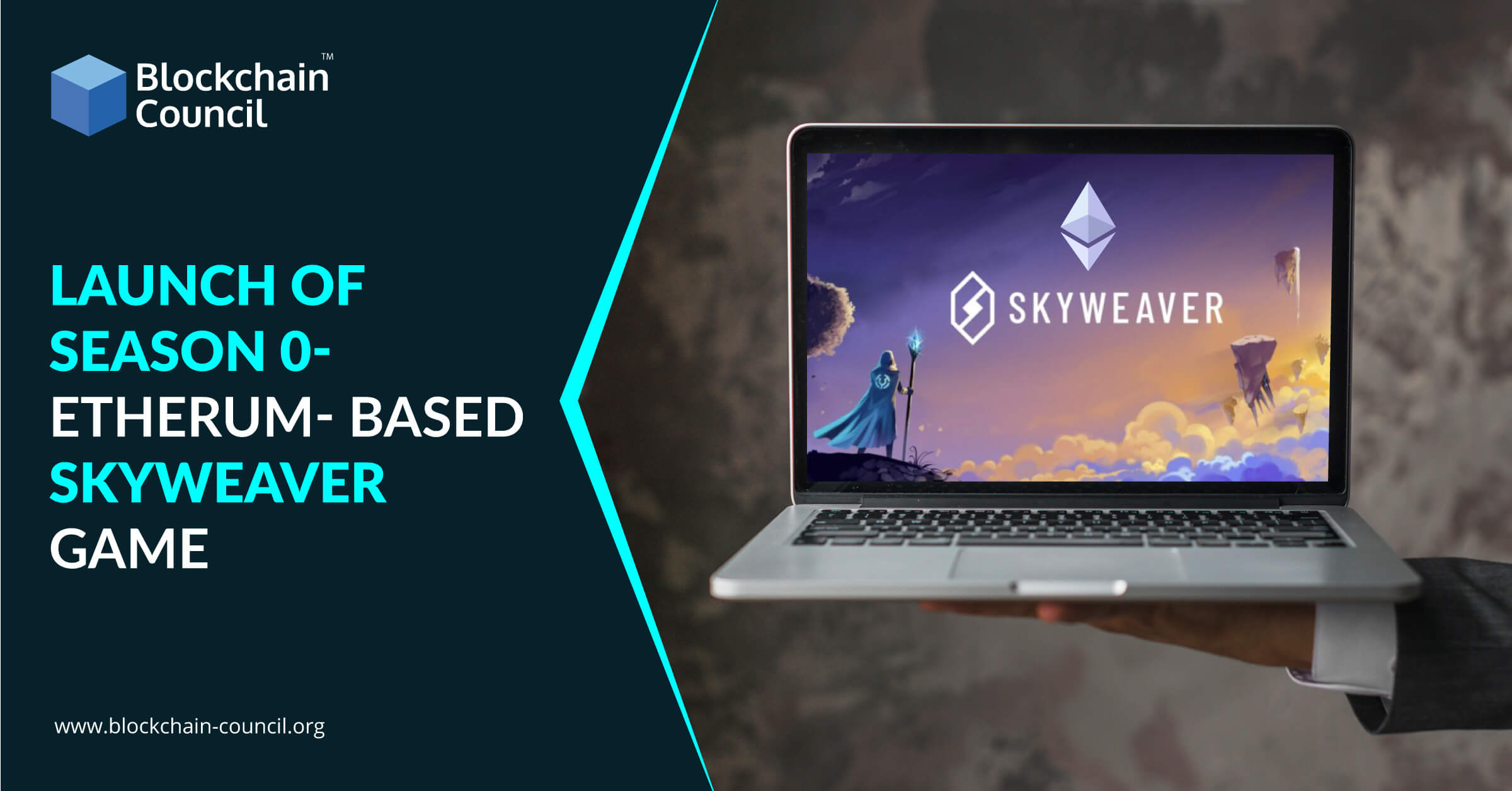
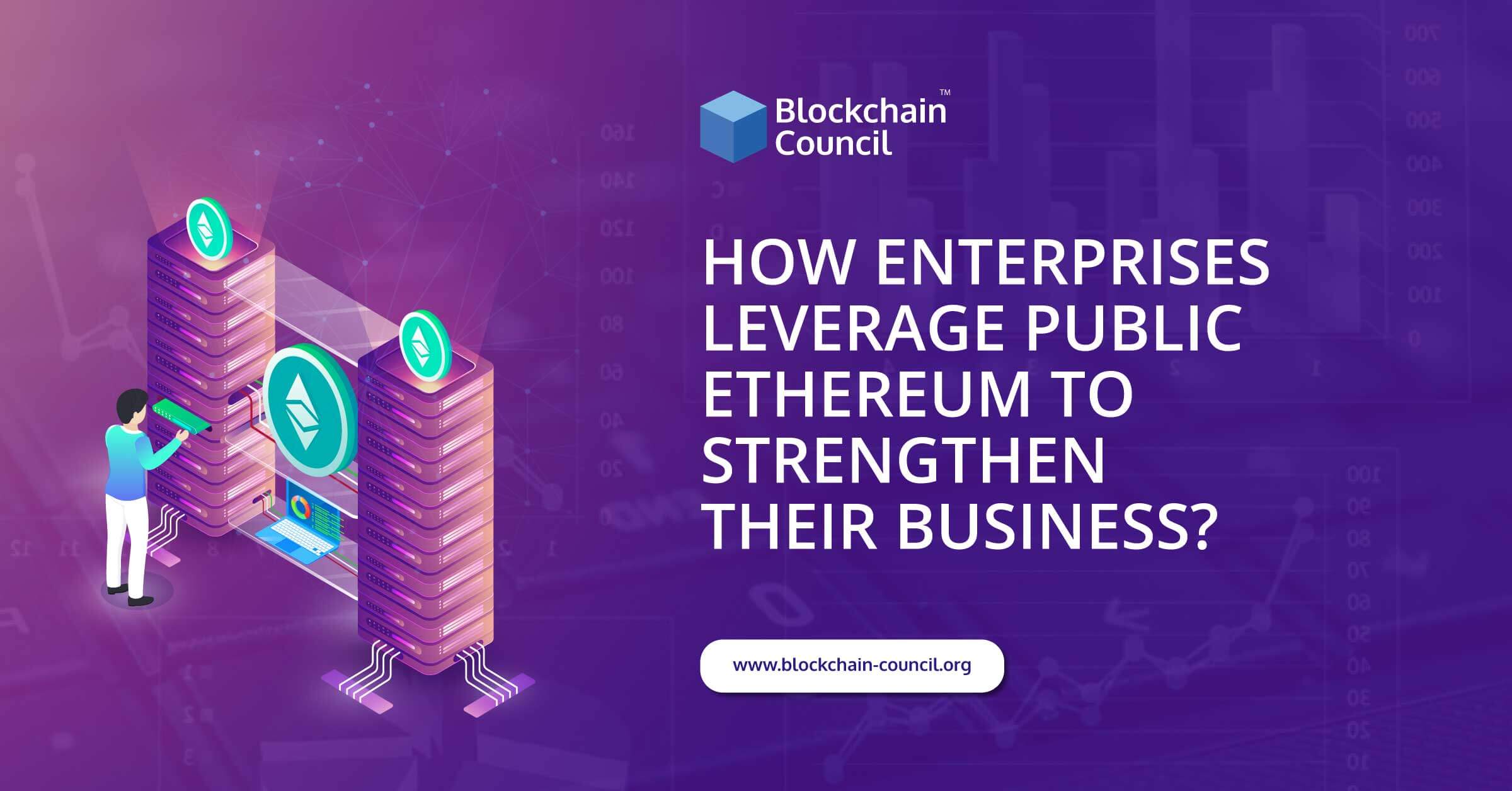
 Guides
Guides News
News Blockchain
Blockchain Cryptocurrency
& Digital Assets
Cryptocurrency
& Digital Assets Web3
Web3 Metaverse & NFTs
Metaverse & NFTs
